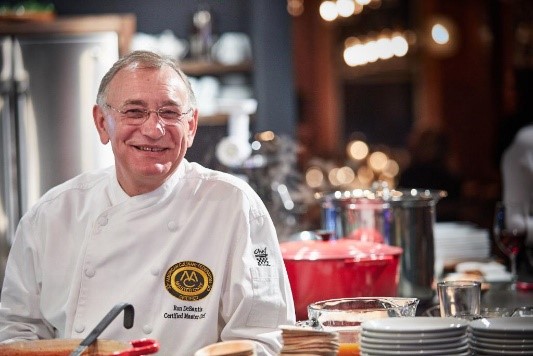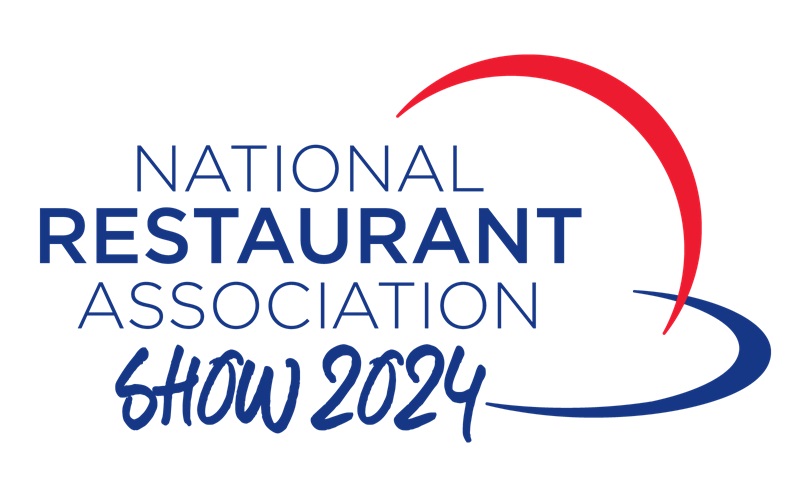Food production planning in a foodservice setting aims at preparing the menu. It is linked to several key functions starting from orders. This is one of the topics in the following newsletter by Certified Master Chef Ron DeSantis.
Food Is Just the Beginning™
by Ron DeSantis
Volume 2 Issue 2
February 2019
CulinaryNXT
200 Totoket Rd
Branford, CT 06405
203-415-9190
Come On, Already!
So, the carrots intended for oblique cut carrots are the size of little league baseball bats. Now what!? In that split second of silence the youngest chef in the room says, “tourné?” Now all eyes are on the Chef (me). Everyone is thinking – is he going to freak out???
Nope, just start tourné.
Cheers!
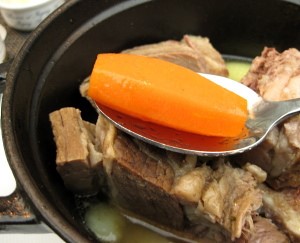
Master Chef Insights
Production Planning
Food production planning is one of the most important functions of a foodservice operation. This function directly impacts operational costs. With a food production plan, the culinary team knows quantities needed for each day’s operation. Production planning also ensures that staffing is adequate, that food is in-house, early preparation steps are done, foods are thawed properly, and many other functions are completed.
Production Planning success is linked to several key functions of a foodservice operation:
- Menu development
- Date of event
- Number of guests
- Standard of service
- Recipe development
- Ingredient sourcing
- Food orders
- Staffing requirements
- Preparation timeline
- Plating diagrams
- Service line set up diagram
- Posted job/task schedules
A Production Planning Framework will generally focus on the following functions:
- Food orders
- Staffing requirements
- Preparation timeline
- Plating diagrams
- Service line set up diagram
- Posted job/task assignments
At the end of this newsletter is a comprehensive “Production Planning” paper.
Culinary & more…
Flavor & The Menu 2019 Trend Report
The 2019 Flavor & The Menu magazine top 10 trends is available on-line. www.getflavor.com
Flavor & The Menu looks at the food industry through flavor. This is the foundation of why we cook food. I’ve been included in this very talented group of industry professionals. The link about will take you to the website and is a great starting place to explore the world of flavor.
Our Food Journey by Hormel Foods
Old-world Knowledge is a wonderful story and podcast from Hormel Foods featuring Columbus Craft Meats’ Evan Inada. Evan is “The Salami Guy” and when you start talking about cured meats with him, it becomes obvious why this name suits him. In the podcast Evan shares important information about traditional salami such as “can you eat the white outside of salami?” The answer is, yes. But there’s so much more to learn about salami.
Please click on the link to read and listen.
Porturken for Super Bowl 53
If I had a newsletter around this time last year, you would have known about my Super Bowl 52, 52 Ingredient Sandwich for Hormel Foods. That baby was the size of a full sheet pan (18” x 26”) and weighed 52 lbs. It didn’t have a name but could have been 523. The 52 was a hit with the media pit at the Mall of America and got several on-air shout outs.
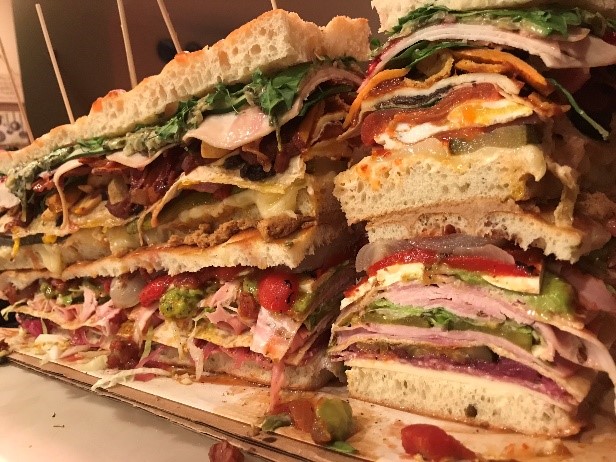
This year I kept ingredients at a more manageable level. After brainstorming with creative friends and churning through a bunch of different ideas, the one that resonated with the Hormel team was – Porturken.
Porturken is a perfect party dish for a big event like Super Bowl. It’s hearty, very satisfying, and has something for everyone. Here’s the breakdown:
A foundation of Black Label Bacon Grits and Mexican street corn holds a skewered tower of (from the tower foundation):
- Fire-braised pork shoulder
- Roasted cauliflower steak
- Fire-braised turkey breast
- Grilled vadalia onion steak
- Fire-braised chicken breast
- Dill pickle
This is brought together with red-eye gravy and a Tabasco aioli.
This is a Super Bowl crowd pleaser. And great fun with food.
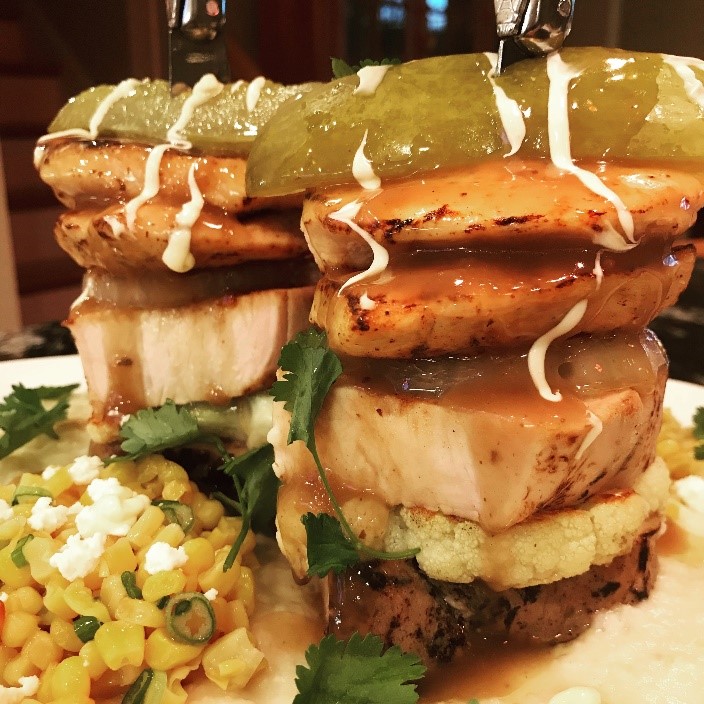
Ingredient of the Month
‘nduja
The world of food never ceases to please me. Food is an on-going learning experience. ‘nduja is just another great ingredient that is a fun experience. It is something like spreadable salami with a spicy kick. I’m discovering that the preparation is flexible and that it’s made from fresh or cured meats. As with most cured meats, it’s packed with flavor and you don’t need a lot to be satisfying.
‘nduja is great spread on bread or used as an ingredient in recipes. I recently spread ‘nduja on halibut, seared it and then served it in a cioppino. The fermented, spicy ‘nduja gave the right amount of flavor boost to the fish.
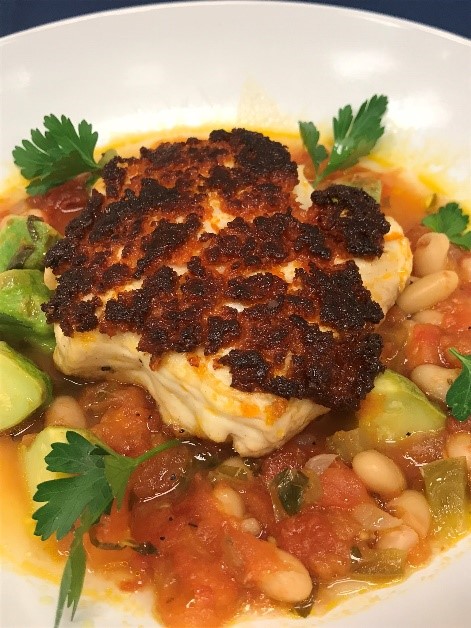
Cooking Tip
Schnitzel
Yes, schnitzel! Think of the last time you had schnitzel….and it was well prepared. Golden outside, crispy, and tender, juicy pork or chicken cutlet inside. Drizzle with fresh lemon juice. FULL STOP. It works! So how to get to that point?
Start with a 4 oz piece of pork or chicken (choose light or dark meat, whatever you like). Place it between plastic wrap and lightly pound with a meat mallet (smooth edge) until 1/8” thick. Drip some water on the meat side of the plastic wrap to help lubricate the meat while pounding. And don’t use the mallet like you hate the meat. Just be firm enough to get it thin. You’ll be amazed at how large the cutlet becomes. If you don’t have a mallet, the back of a fry pan works or a rolling pin.

Next is the standard breading procedure. Flour, egg, bread crumbs. Season the flour and the egg. I mix panko and regular bread crumbs (I feel that it covers the meat better). Start by dredging the cutlet in the flour, shake excess off. Dip in beaten egg, then into the bread crumb mix to coat completely. This can be made ahead and kept refrigerated until time to fry.
Pan-fry in fresh, clean oil. The temperature is key. The oil should be hot so that the schnitzel fries quickly. The temperature is right when is browns in 2-3 minutes on each side and the coating lightly souffles. The souffle part is desirable but not a deal-breaker. Just keep trying, you’ll get there.
Here’s how to test the oil temperature. Place a slice of bread in the pan. If nothing happens – too cold. Let the oil heat up more. If it gets black in seconds – too hot. Let the oil cool or just add additional oil to cool everything down. Once a piece of bread fries quickly (2-3 minutes) to a gold brown, the oil is ready. Now, fry the schnitzel 2-3 minutes on each side.
Lastly, eat it right away. Schnitzel is one of those “Eat it Now” foods (September 2018 newsletter). The crisp of the crust, with the moist cutlet inside, and fresh lemon is a timeless combination.
Guten appetit.
Keep scrolling!
CulinaryNXT is a food service advisory practice drawing on Ron DeSantis’ 30 years of experience in all facets of the food industry. Ron is one of only 68 Certified Master Chefs worldwide and has advised organizations of all sizes and types. His strengths include culinary innovation, menu and recipe development, culinary assessment, bottom-line results, and communication skills that allow him to implement solutions effectively.
CulinaryNXT’s base is in New Haven, but its reach is truly global. CulinaryNXT’s relationships extend to numerous countries around the world in a client and alliance network that has been built over many years. These relationships provide both global support and local knowledge.
Production Planning
Once a menu has been determined, production planning becomes the roadmap to getting things done. “Plan the work and work the plan” has been said countless times for good reason. Planning provides everyone in the operation with a clear overview of production. Planning also defines how all the parts come together and provides the team with an understanding of their role in the operation.
Successful planning starts with the end in mind. In a foodservice setting the menu is the end. Planning then works in reverse. The creation of a planning timeline starts when foods are served. The chef plans plating times, cooking times, preparation times, food orders, and scheduling based on the service time. Other elements of planning include, plating diagrams, service line set up, and posted job/task schedules.
Production Planning success is linked to several key functions of a foodservice operation:
- Menu development
- Date of event
- Number of guests
- Standard of service
- Recipe development
- Ingredient sourcing
- Food orders
- Staffing requirements
- Preparation timeline
- Plating diagrams
- Service line set up diagram
- Posted job/task schedules
A Production Planning Framework will generally focus on the following functions:
- Food orders
- Staffing requirements
- Preparation timeline
- Plating diagrams
- Service line set up diagram
- Posted job/task assignments
Food Orders
Using kitchen management systems, the production team can scale recipes for the selected menu and review inventory for on-hand supplies needed to produce the menu. Then food orders are placed early to allow production team to trim, marinate, thaw, or other pre-preparation procedures.
Staffing Requirements
Production staffing is based on production needs leading up to the event. Generally, these are more streamlined than event day staffing. Event day staffing will vary according to the standard of service of the event.
Preparation Timeline
The timeline is the core of the production schedule. The timeline is created by starting at the scheduled time of food pick-up by waitstaff or buffet set-up (standard of service) and scheduling preparation and cook-times from that point. Here again, kitchen management systems provide functions to automate the production schedule framework.
The event day timeline is a granular schedule clearly scheduling each time-block of the day. The production team determines the structure of the time-block and then builds the timeline. Event day timelines include information such as:
- plating time for cold items
- inventory of china
- cooking of each menu item
- service line set up
Production Timelines are always publicly posted so that all team members have access to the information.
Plating Diagrams
Diagrams of photos of the completed plate, platter, or other serviceware are excellent tools for the production and event day team. This tool allows the culinary team to see the finished food.
Service Line Set-up Diagram
Posting the set-up of the service line depicting each menu item to be plated (pick) has multiple functions:
- Easy service line set-up
- No picks are forgotten
- Placement of picks is clearly determined
- Tools required for plating are identified
- Picks are placed in proper plating sequence
Posted Job/Task Assignments
Each job assignment pertaining to production and event day preparation is posted for the culinary team. This assigns responsibility and accountability for each menu item.
Success isn’t guaranteed with production planning, but it is a tool that significantly contributes to an operation’s success. Many elements of the process are developed or documented once, then used as a standard operating procedure – SOP – for future production. Best practices include reviewing SOPs periodically for adjustments and/or revisions. Planning is a crucial part of a chef’s responsibilities.
Manage Food Production with cloud-based JAMIX Kitchen Intelligence System

